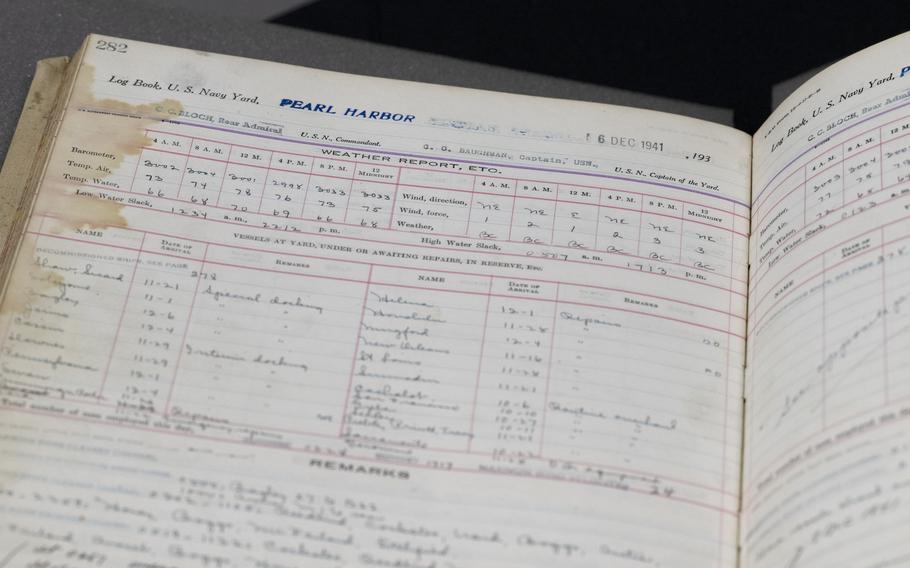
The historic log book was nearly thrown away before being saved by a curious civilian employee at the old Norton Air Force Base in San Bernardino, Calif. (Marvin Joseph/The Washington Post)
As Tracylyn Sharrit helped her fiancé unpack his books during his move last year, a large volume with stained pages caught her eye. It said “U.S. Navy Yards and Naval Stations” and “Government Bindery” on its spine.
It was an account of the daily weather, tides and other conditions for several months in 1941 and ’42. It noted the arrival and departure of ships. At the top of each page it said “Log Book, U.S. Navy Yard Pearl Harbor.”
She flipped through it, and on Pages 282 and 283 there were entries for Dec. 6 and 7, 1941. Under “remarks,” someone had written in pen: “0755 Japanese aircraft and submarines attacked Pearl Harbor and other military and naval objectives ...”
“Dude,” Sharrit said she told her fiancé, Michael William Bonds. “You know what you have here?”
It was the log book from Navy Yard Pearl Harbor, covering the 16 months before and after the attack that pushed the United States into World War II. On Wednesday, the National Archives announced that it had recovered the book from the couple earlier this year.
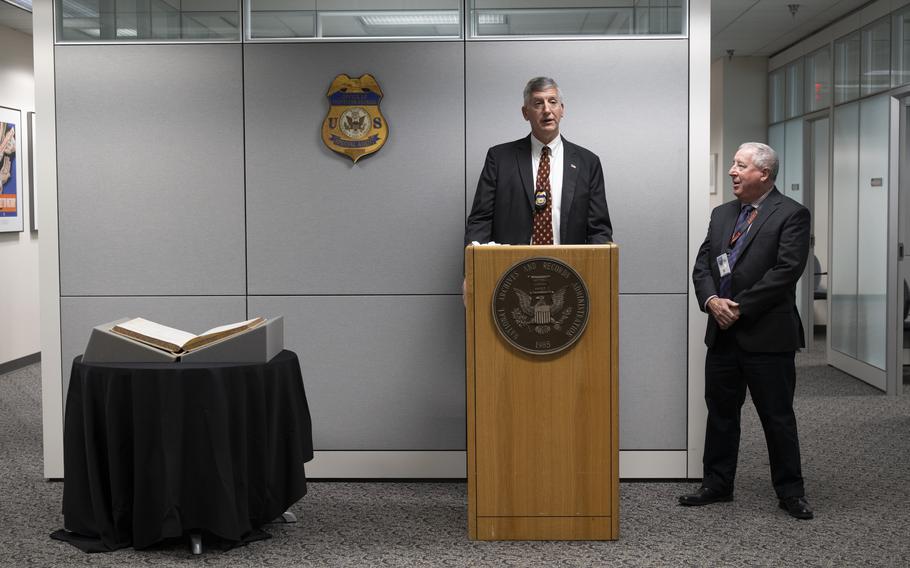
David Stupar, left, the National Archives special agent, and investigative archivist Mitchell Yockelson talk about the recently recovered log book. (Marvin Joseph/The Washington Post)
“It’s a very big deal,” said David Stupar, the Archives special agent who retrieved the book from Sharrit and Bonds, of Hemet, California, in April. The book is in good condition and its spare notations provide snapshots of history as it was happening, he said.
“We have nothing, nor does the nation have anything similar to this,” Mitchell Yockelson, an investigative archivist at the agency, said as the book was unveiled at the Archives facility in College Park, Maryland.
A digitized copy is available online.
The book may not alter the basic story of Pearl Harbor, where on Sunday, Dec. 7, 1941, Japanese war planes attacked American installations near Honolulu, Archives officials said. Many U.S. ships were sunk or damaged and more than 2,400 sailors, Marines, soldiers and civilians were killed.
The book essentially verifies the story of Pearl Harbor, Yockelson said. “Whether or not it will change the interpretation, that’s up to the historians out there.”
In addition to the Dec. 7 attack, the log book also mentions the little-known second attack on Pearl Harbor on March 4, 1942, by two big Japanese seaplanes:
“0045 received report of unidentified planes approximately 50 miles away. 0050 assumed condition one. 1705 three shots and whistling projectiles heard. 1710 received report that two fragments of bombs hit astern of [USS] Ortolan ...”
But visibility was poor for the Japanese aviators that night and the attack did little damage.
Navy ships and bases kept log books, which were daily records, in brief, of events and observations. In this case, the log documents some of the ships that were at Pearl Harbor the day of the attack, Yockelson said.
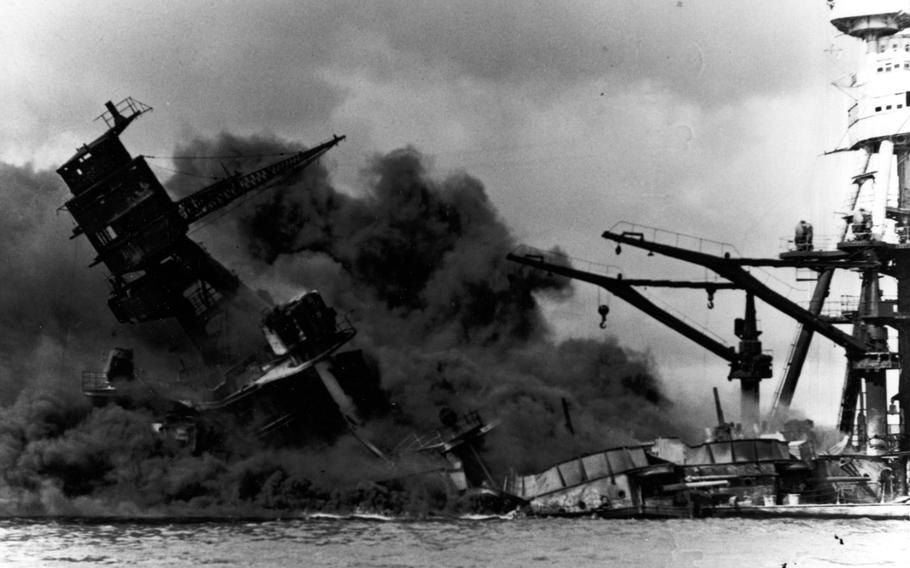
The USS Arizona arrived at Pearl Harbor on Dec. 5, 1941. It was sunk two days later. (Naval History and Heritage Command)
sThe entry for Dec. 5, 1941, records the arrival in the harbor of the battleships USS Arizona and USS Oklahoma. Both were sunk in the attack two days later.
The entry for Dec. 6, 1941 lists the battleship USS Pennsylvania and the destroyers USS Cassin, USS Downes, and USS Shaw present in the yard, where they were undergoing repairs. The next day, all three were damaged — the destroyers heavily.
On Dec. 8, as stricken ships still burned in the harbor, the log reported at 7:35 a.m. that the damaged battleship USS Utah “appears to be drifting out in the channel, recommend tug be sent to secure it along side quay.”
At 9:30 p.m.: “Tower reports fire at ammunition depot.”
At 1o:15 p.m.: “Fire at Hickam field secured.”
The pages for Dec. 6 and 7 have brown stains, apparently from a liquid. Could it have been coffee spilled by some frantic officer?
“That’s another question that we’ve been wondering” about, Yockelson said. “We like to think that maybe ... somebody was so agitated at what went on that he spilled his thermos.”
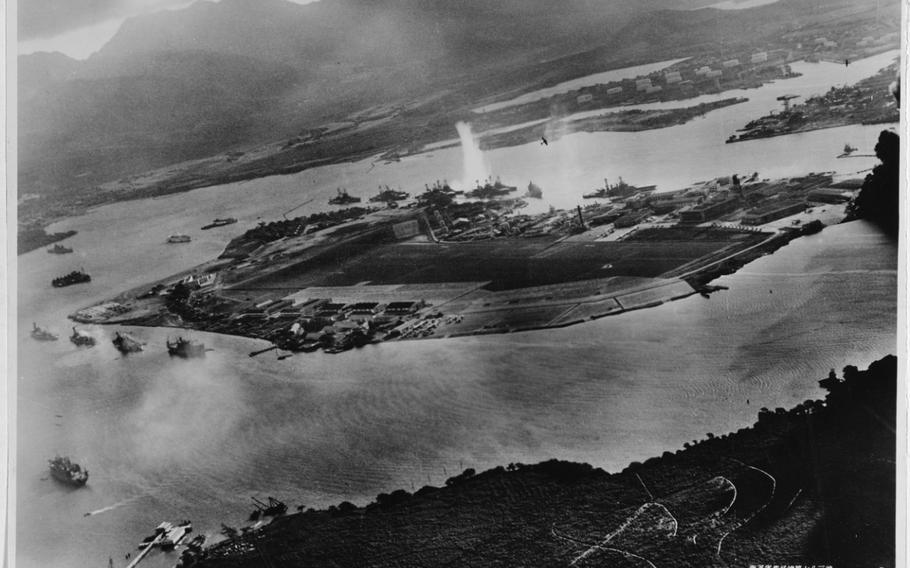
This photo was taken from a Japanese plane during the attack on Pearl Harbor on Dec. 7, 1941. (Naval History and Heritage Command)
The book, which is more than 80 years old, was saved from destruction by Bonds’s late mother, Oretta Kanady, Bonds said in a recent telephone interview.
During the 1970s she was a civilian employee at the old Norton Air Force Base in San Bernardino, California, and one day noticed the book in a trash bin, Bonds, 65, said. It looked interesting and she asked if she could have it.
“They said, ‘Yeah, go ahead,’” he said. “She brought it home to me. I was like 15 or so. I’ve had it ever since.” He said he doesn’t recall thinking much of it.
“In the last few years, I’ve moved here, moved there, it’s just been in a box,” he said. “I hadn’t really looked at it.”
In 2000, his mother died. Archives officials said they don’t know how the book might have gotten from a Navy base at Pearl Harbor to the trash at an air base in California.
“Were there other log books in the same trash?” Stupar, the special agent, said. “We just don’t know.”
Last fall, Bonds moved into Sharrit’s two-bedroom home in an over-55 community in Hemet, about 85 miles east of Los Angeles.
Bonds said he drives a forklift at a local Amazon facility. After Sharrit, 57, pointed out the historical importance of the book, the couple decided it might be valuable and decided to sell it.
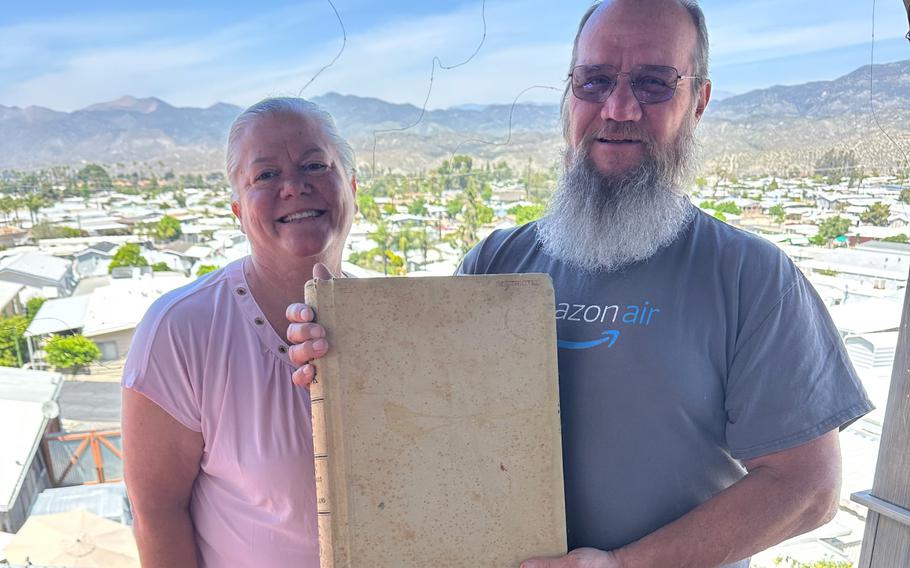
Tracylyn Sharrit, left, and Michael William Bonds hold the historic log book from the Navy Yard Pearl Harbor. (David Stupar and Tracylyn Sharrit)
Sharrit contacted the office of Whitmore Rare Books in Pasadena, Calif.
“They reached out to me,” Dan Whitmore, the company’s founder, said in a telephone interview. He said he deals mainly in literary first editions, and books on philosophy, science and economics.
“But when someone reaches out and says, ‘Hey we’ve got the station log book during the attacks of Pearl Harbor,’ your ears perk up,” he said. “That’s a significant cultural object.”
Its potential value was unclear, he said.
“I don’t know exactly what a retail price point would be for it,” he said. “It could be a six-figure object.”
“It doesn’t have a lot of color, in the actual object itself,” he said. “It’s fairly dry. ... At the same time it’s the station log book so it kind of has the weight of authority. ... It’s the one. I don’t think there is another one.”
Even though it was said to have been in the trash, it looked like it might still be government property. It was a gray area. “We reached out to the National Archives,” Whitmore said.
“We didn’t want to buy a problem or buy a headache and we certainly didn’t want to pass on a headache to potential customers,” he said. “We wanted to make sure that the National Archives didn’t have a claim on it.”
Whitmore put the Archives in touch with Sharrit and Bonds, and Archives officials told them that even though Kanady had rescued it from the trash and Bonds had saved it, the log was still a piece of historic government property.
“We’re grateful to them for what they did,” Yockelson, the investigative archivist, said. Had Kanady not found it, “we can assume that it would have ended up destroyed.”
But it belonged in the Archives. Stupar flew to California to retrieve it, carrying two gray National Archives T-shirts with words from the Constitution for the couple as souvenirs.
Bonds said he was not that happy about it. “I’d like to have gotten some compensation for it,” he said. If not for his mother, “it would have been gone and nobody would have ever seen it again.”
He said arrangements were being made for the couple to get a tour of the San Diego Navy base.
“All I got was a T-shirt so far,” he said.
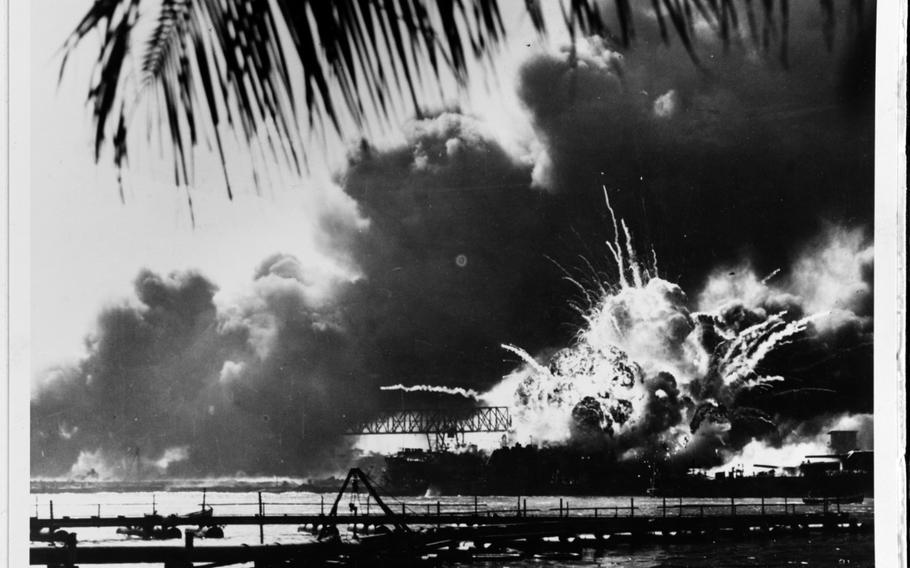
An explosion occurs the USS Shaw during the Japanese attack on Pearl Harbor on Dec. 7, 1941. (Naval History and Heritage Command)